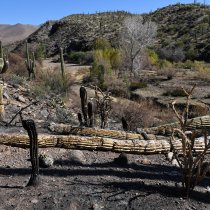How is a deer mouse like a grad student?
October 3, 2011
By Kate Thibault
The majestic, 500-pound lion lazing in the grass awaiting its next meal (provided generously by the females in his pride). The surprising, 20-foot-tall giraffe grabbing leaves with its foot-and-a-half-long tongue. The bizarre bouncing deer with a pouch, the kangaroo. These charismatic megafauna can’t help but inspire awe and curiosity in most people. As a scientist that studies wild mammals, I too revel in the incredible diversity and occasional absurdity of these critters.
But I see these species as ‘gateway species’ because they get people who might otherwise not be so inclined to get hooked on the natural world. And once people are hooked, you can introduce them to the real, hard-core mammals—the ones that are small, extremely abundant, and easy to overlook. These characteristics imbue these species with a scientist’s favorite trait in a mammal—easy to study (relatively anyway—I realize not everyone finds hauling traps into remote places or poking and prodding individuals in a laboratory easy). Because of this relative ease of study, we learn a lot from these species—most of our knowledge about mammals really comes from these not-as-charismatic minifauna. In North America, the hardest-core mammal is definitely the North American deer mouse (Peromyscus maniculatus)—a focal species of NEON small mammal work. The deer mouse is the most widespread rodent in North America. It occurs across most of the continent, with the exception of much of Alaska, northern Canada, western and southeastern Mexico, and the southeastern U.S. There are about 14 other similar, closely related species (in the same genus) in North America, but none of these have reached the level of fame and fortune as the North American deer mouse.
This species has such a ginormous geographic range because it can pretty much eat anything and live anywhere. It eats everything from seeds to bugs to fungi, and occurs in virtually any and every habitat available throughout this range, from desert to boreal forest. It can also have up to 8 adorable pups in a litter, and, in the laboratory where food is cheap, it can have up to 14 litters a year and live for 8 years. Finally, it is an extremely variable beast, on the inside and out. For example, its fur can be any shade of brown or, if it lives in lava fields, it can be black as night. When it’s cold outside, deer mice just build a bigger and better nest and invite a handful of friends over for some snuggling. As our parents taught us, there are many downsides to an ‘anything goes’ lifestyle. From our perspective, the biggest downside to the incredible flexibility of the deer mouse is its fondness for sharing our homes with us, particularly for those that live in rural areas. If you have a really cute, big-eared mouse eating your oatmeal, building nests with your paper towels, and pooping under your sink, it is probably a deer mouse. The good news is that one of the reasons we scientists love the deer mouse is good for everyone—they love free food in a trap just as much as a grad student loves free pizza.
Because it occurs in a lot of places and often in abundance, the deer mouse is a major prey species for a lot of medium-sized carnivores—foxes, skunks, and weasels, to name a few. Although this is unfortunate for the individuals that become prey, this is great service for biodiversity in general. For the same reasons, the deer mouse is also a perfect vehicle for infectious diseases—namely hantavirus, plague, and Lyme disease – which makes understanding the population dynamics of this species important for public health. Don’t panic—these diseases are often treatable and, you are, of course, much more likely to die in your car or even by a lawn mower. Just be safe—follow the CDC guidelines for safe clean-up of the things deer mice leave behind. Now you know more about the most common species in your backyard and most of North America than most people do. If you keep following NEON, we will learn even more about this very important critter together, and come to appreciate that there is much more to life than charismatic megafauna.
